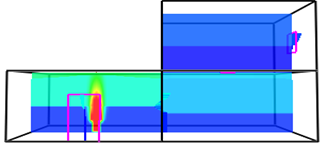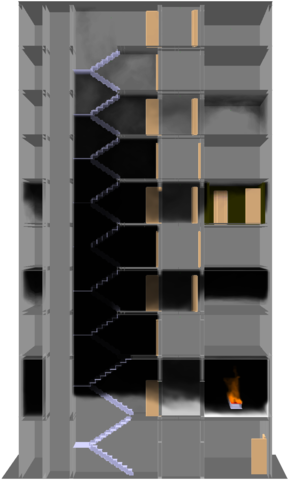Computer fire models and practical applications (1990s)
- Computer models are an important tool for understanding and controlling fire.
- NIST has created two groundbreaking computer programs for modeling fire and made them free to the public.
- Those two models, CFAST and FDS, are the most widely used tools worldwide for estimating fire safety and reconstructing fires for forensics.
Real-life experiments are a valuable tool for understanding fire, but physically burning something in the lab can be expensive, time-consuming and dangerous. Sometimes a real test burn isn’t even possible. That’s where computer simulations come in.
A valid computer model can help you simulate a fire to see if a building is safe. Or, after a real fire has already happened, a model can help you recreate the fire to understand how the fire likely started and spread.
Over the years, NIST researchers have developed two computer programs, CFAST and FDS, that simulate the spread of fire and smoke. They also developed a visualization program, Smokeview, to help users understand CFAST and FDS. These fire models are widely used around the world and are completely free for anyone to download and use.
CFAST, a zone model
For even the world’s fastest computers, it would be impossible to simulate every molecule in a fire. That’s why the first step in designing a model is to simplify the problem into manageable chunks.
In a room fire, air generally separates into two layers: hot, smoky air near the ceiling and cool, breathable air below. Treating each room as just two uniform zones dramatically simplifies the work of modeling a fire. Instead of doing calculations for every tiny part of the room, researchers only need to do one set of calculations for the top and one set of calculations for the bottom. The approach is called a “zone model” because of the way it simplifies the problem into these zones.
A computer simulation is only useful if you can prove that it works by comparing it to fires in the real world. Working with the Fire Protection Research Foundation, NIST showed that one of its early zone models successfully replicated the survival rate and cause of death for U.S. residential furniture fires.

NIST’s research on zone models led to the creation of the Consolidated Fire and Smoke Transport, known as CFAST. The user starts by entering information about the building, the fire and the combustible things in each room. CFAST uses physics to calculate important numbers like the height and temperature of each zone and how gases spread through the building.
The simplification makes this model quick. On an ordinary personal computer, CFAST can simulate a fire in more than 60 rooms of a 10-story building in less than one minute.
This model is used extensively by safety engineers to evaluate a building’s fire safety and in courtrooms to resolve legal disputes following a fire.
FDS, a computational fluid dynamics model
CFAST works well for many applications, but more complicated rooms and fires need more complicated models.
CFAST is fast because it only does calculations for two zones per room. You can get more detail by using many more, smaller zones. That’s the basic principle behind computational fluid dynamics (CFD) modeling.
In NIST’s CFD models for fire, the area you’d like to simulate is divided into a grid made up of numerous smaller cubes. The size of each cube can be anywhere from millimeters to meters across depending on what you need the model to do. Starting at the edges of the model, the program does calculations to see how smoke or heat moves through the cubes. Then it looks at how those cubes affect their neighbors, and so on until the entire area is simulated.
After the 1989 Exxon Valdez oil spill, NIST needed a new computer model to see whether it was better to burn the spilled oil out in the ocean or let it wash up on shore. Researchers came up with a CFD model called a Large Outdoor Fire Plume Trajectory (ALOFT) to simulate the plume of smoke. The researchers made sure ALOFT worked by comparing it to the burning of a real oil spill.
Before this research, burning spilled oil was seen as a method of last resort. But ALOFT showed that if done carefully, burning oil spills could be an effective strategy for protecting the coastline.
The success of ALOFT at modeling turbulent smoke outdoors caused NIST researchers to wonder: Is it possible to model complex fire and smoke indoors?
The answer to that question turned out to be yes. The result: The Fire Dynamics Simulator (FDS), a CFD model that is now commonly used worldwide for guidance on indoor fire protection. For example, it helps engineers find the best way to install smoke handling systems, smoke alarms and automatic fire sprinklers.
It is also the primary tool used in forensics to reconstruct a fire and was used in the investigation of the World Trade Center collapse.
Smokeview, visualization software

CFAST and FDS are powerful tools, but it would be difficult to use them without visualization software to show the user what the numbers mean. That’s why NIST staff developed Smokeview. Smokeview is the eyes that make it easy to see and understand CFAST or FDS. It can turn the calculations from CFAST or FDS into data plots, images and even colorful movies.
Using Smokeview with FDS data, users can watch the movement of the flames, the loss of visibility due to soot, the flow and temperature of air as it moves to and from the fire zone, and the resulting temperature profiles of the ceiling, walls and any objects in the flow path.
Computer simulations are an important part of almost all fire research done today. NIST played an important role in developing this technology and making it available for anyone to use.
Additional Reading:
NIST software: Consolidated Fire and Smoke Transport (CFAST).
NIST report: Reference Guide for the HAZARD I Fire Hazard Assessment Method, 1991.
NIST software: Fire Dynamics Simulator (FDS) and Smokeview.
Journal article: In Situ Burning of Oil Spills. Journal of Research of the National Institute of Standards and Technology, 2001.

